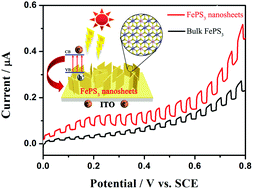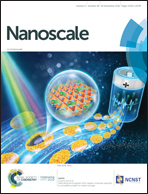Iron phosphorus trichalcogenide ultrathin nanosheets: enhanced photoelectrochemical activity under visible-light irradiation†
Abstract
Exploiting novel visible-light sensitive materials for the photoelectrochemical (PEC) technique is deeply meaningful for energy conversion and analytic detection. Owing to the tunable bandgap structure and strong absorption of visible light, the rising-star two-dimensional (2D) metal phosphorus trichalcogenide (MPX3) nanomaterials are expected to be promising photochemical sensitizers toward PEC biosensors. Moreover, guided by DFT calculations, the FePS3 nanosheets possessed a narrower bandgap than the bulk form, thereby enabling high availability of visible-light absorption for the FePS3 nanosheets. In this work, 2D FePS3 nanosheets were successfully synthesized by a facile salt-templated method. By tuning the proportion of the salt template, the thickness of the FePS3 nanosheets could be manipulated. As a result, the FePS3 nanosheets exhibited an obviously enhanced photoelectrochemical behavior with visible light and sensitive detection towards glucose. Being the first experimental report regarding the MPS3 nanosheets toward PEC activity, our finding can be an essential stepping stone in the pursuit of the further exploration of other 2D materials for the PEC technology.



 Please wait while we load your content...
Please wait while we load your content...